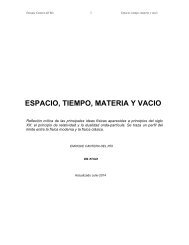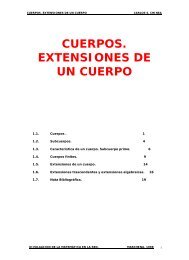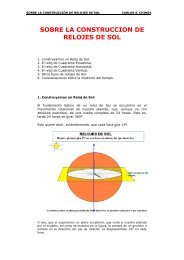Acerca de los homomorfismos - Casanchi
Acerca de los homomorfismos - Casanchi
Acerca de los homomorfismos - Casanchi
Create successful ePaper yourself
Turn your PDF publications into a flip-book with our unique Google optimized e-Paper software.
<strong>Acerca</strong> <strong>de</strong> <strong>los</strong> <strong>homomorfismos</strong><br />
Car<strong>los</strong> S. Chinea<br />
<strong>Acerca</strong> <strong>de</strong> <strong>los</strong> <strong>homomorfismos</strong><br />
1. Homomorfismos<br />
2. Operaciones<br />
3. Relaciones<br />
4. Los teoremas <strong>de</strong> isomorfía<br />
5. Existencia <strong>de</strong> <strong>homomorfismos</strong><br />
1. Homomorfismos<br />
1.1. La i<strong>de</strong>a <strong>de</strong> homomorfismo:<br />
Definición 1_1<br />
Dados dos espacios vectoriales sobre el mismo cuerpos k <strong>de</strong> escalares, (V,k) y<br />
(V’,k) se <strong>de</strong>nomina homomorfismo <strong>de</strong>l espacio (V,k) al espacio (V’,k) a toda<br />
aplicación f : V → W que verifique las condiciones <strong>de</strong> linealidad<br />
∀ x , y ∈V<br />
, f ( x + y)<br />
= f ( x)<br />
+ f ( y)<br />
∀ x ∈V<br />
, ∀α ∈ K,<br />
f ( αx)<br />
= αf<br />
( x)<br />
Representaremos por Hom(V,V’) al conjunto <strong>de</strong> todos <strong>los</strong> <strong>homomorfismos</strong>,<br />
aplicaciones lineales, <strong>de</strong>l espacio (V,k) en el espacio (V’,k).<br />
Si un homomorfismo es biyectivo, se llamará isomorfismo, y si es inyectivo,<br />
monomorfismo. Si la aplicación es sobreyectiva, diremos que es un epimorfismo.<br />
La siguiente proposición es una consecuencia inmediata <strong>de</strong> la <strong>de</strong>finición <strong>de</strong><br />
homomorfismo.<br />
Proposición 1_1<br />
Si f es homomorfismo se cumple que:<br />
a) f(0)=0<br />
b) f(-x)=-f(x), ∀ x ∈V<br />
En efecto:<br />
a) Aplicamos la segunda condición <strong>de</strong> linealidad: ∀x ∈V ,<br />
b) Igualmente: ∀ x ∈V , f(-x)=f((-1).x)=(-1).f(x)=-f(x)<br />
f(0)=f(0x)=0.f(x)=0<br />
Esta otra proposición permite caracterizar <strong>los</strong> <strong>homomorfismos</strong> mediante una<br />
sencilla condición.<br />
Proposición 1_2:<br />
La condición necesaria y suficiente para que la aplicación f : V → V ' sea lineal, es<br />
que<br />
f ( α x + βy)<br />
= αf<br />
( x)<br />
+ βf<br />
( y),<br />
∀x,<br />
y ∈V<br />
, ∀α,<br />
β ∈ K<br />
Demostración:<br />
- condición necesaria: aplicamos directamente ambas condiciones <strong>de</strong> linealidad<br />
f ( α x + βy)<br />
= f ( αx)<br />
+ f ( βy)<br />
= αf<br />
( x)<br />
+ βf<br />
( y),<br />
∀x,<br />
y ∈V<br />
, ∀α,<br />
β ∈ K<br />
- condición suficiente: hacemos α=1, β=1 para obtener la primera condición <strong>de</strong><br />
linealidad, y hacemos q=0 para obtener la segunda:<br />
1
<strong>Acerca</strong> <strong>de</strong> <strong>los</strong> <strong>homomorfismos</strong><br />
Car<strong>los</strong> S. Chinea<br />
Hacemos α=1, β=1:<br />
f ( α x + βy)<br />
= αf<br />
( x)<br />
+ βf<br />
( y),<br />
∀x,<br />
y ∈V<br />
→ f ( x + y)<br />
= f ( x)<br />
+ f ( y),<br />
∀x,<br />
y ∈V<br />
- Hacemos β=0:<br />
f ( α x + 0y)<br />
= αf<br />
( x)<br />
+ 0 f ( y),<br />
∀x,<br />
y ∈V<br />
→ f ( αx)<br />
= αf<br />
( x),<br />
∀x<br />
∈V<br />
, ∀α<br />
∈ K<br />
En el caso <strong>de</strong> que el espacio origen y el espacio imagen coincidan (V=V’), se<br />
introduce la i<strong>de</strong>a <strong>de</strong> endomorfismo.<br />
Definición 1_2: Se <strong>de</strong>nomina endomorfismo en el espacio (V,k) a un homomorfismo<br />
f:VV, esto es, un homomorfismo <strong>de</strong> V en V. El endomorfismo se llama<br />
epimorfismo si la aplicación f es sobreyectiva, monomorfismo si es inyectiva y<br />
automorfismo si es biyectiva. Representaremos por End(V) al conjunto <strong>de</strong> todos <strong>los</strong><br />
endomorfismos en V.<br />
1.2. Homomorfismos y varieda<strong>de</strong>s lineales<br />
Definición 1_3:<br />
Un subconjunto L <strong>de</strong> vectores <strong>de</strong> un espacio vectorial (V,k) es una variedad lineal<br />
<strong>de</strong> V si tiene también estructura <strong>de</strong> espacio vectorial con respecto al mismo cuerpo<br />
<strong>de</strong> escalares k.<br />
Proposición 1_3:<br />
La condición necesaria y suficiente para que un subconjunto L ⊂ V sea variedad<br />
lineal <strong>de</strong>l espacio (V,k) es que∀ x,<br />
y ∈ L,<br />
∀a,<br />
b∈<br />
k,<br />
ax + by ∈ L<br />
Demostración:<br />
- Condición suficiente:<br />
Haciendo a=1,b=1, ∀ x, y ∈ L,<br />
∀a,<br />
b∈<br />
k,<br />
ax + by ∈ L → x + y ∈ L , luego la suma <strong>de</strong><br />
vectores es interna en L, y tiene las mismas propieda<strong>de</strong>s <strong>de</strong> grupo que tiene en V.<br />
Haciendo b=0, ∀ x ∈ L, ∀a<br />
∈ K,<br />
ax ∈ L , y tiene las mismas propieda<strong>de</strong>s <strong>de</strong>l producto<br />
<strong>de</strong> un vector por un escalar que tiene en V. Luego (L,k) es espacio vectorial,<br />
subespacio <strong>de</strong>l espacio vectorial (V,k).<br />
- Condición necesaria: trivialmente, ∀x , y ∈ L,<br />
∀a,<br />
b∈<br />
K ∧ L espacio vect →<br />
→ ax ∈ L,<br />
by ∈ L → ax + by ∈ L<br />
Proposición 1_4:<br />
Para todo homomorfismo f : V → W se verifica que<br />
a) Si L es variedad lineal <strong>de</strong> V, entonces f(L) es variedad lineal <strong>de</strong> W.<br />
b) Si L’ es variedad lineal <strong>de</strong> W, entonces f -1 (L’) es variedad lineal <strong>de</strong> V.<br />
Demostración:<br />
a) Hemos <strong>de</strong> probar que∀x' , y'<br />
∈ f ( L),<br />
α x'<br />
+ βy'<br />
∈ f ( L),<br />
∀α,<br />
β ∈ K .<br />
∀x',<br />
y'<br />
∈ f ( L),<br />
∃x,<br />
y ∈ L / f ( x)<br />
= x',<br />
f ( y)<br />
= y'<br />
∧L<br />
varlineal<br />
→ αx<br />
+ βy<br />
∈ L,<br />
∀α,<br />
β ∈ K →<br />
→ f ( αx<br />
+ βy)<br />
∈ f ( L)<br />
→ αf<br />
( x)<br />
+ βf<br />
( y)<br />
∈ f ( L)<br />
→ αx'<br />
+ βy'<br />
∈ f ( L)<br />
−1<br />
−1<br />
b) Hemos <strong>de</strong> probar que∀x,<br />
y ∈ f ( L),<br />
α x + βy<br />
∈ f ( L),<br />
∀α,<br />
β ∈ K .<br />
∀x,<br />
y ∈ f<br />
−1<br />
( L)<br />
→<br />
→ f ( αx<br />
+ βy)<br />
∈ L → αx<br />
+ βy<br />
∈ f<br />
f ( x),<br />
f ( y)<br />
∈ L ∧ L varlineal<br />
→ αf<br />
( x)<br />
+ βf<br />
( y)<br />
∈ L,<br />
∀α,<br />
β ∈ K →<br />
−1<br />
( L)<br />
La siguiente proposición es una consecuencia inmediata <strong>de</strong> la proposición 1_4.<br />
Proposición 1_5:<br />
a) f (V ) es variedad lineal <strong>de</strong> V’.<br />
2
<strong>Acerca</strong> <strong>de</strong> <strong>los</strong> <strong>homomorfismos</strong><br />
Car<strong>los</strong> S. Chinea<br />
b) f −1 (0)<br />
es variedad lineal <strong>de</strong> V.<br />
Ambas varieda<strong>de</strong>s lineales se <strong>de</strong>nominan respectivamente variedad imagen, y<br />
núcleo <strong>de</strong>l homomorfismo. Pue<strong>de</strong>n ser simbolizadas por img (V ) y ker f ,<br />
respectivamente.<br />
Demostración:<br />
a) Trivialmente, puesto que V es una variedad lineal <strong>de</strong> si misma, img (V)=f(V) es<br />
variedad lineal <strong>de</strong>l espacio imagen V’.<br />
b) Análogamente, al ser { 0 } variedad lineal <strong>de</strong> W, es ker f=f -1 (0) variedad lineal<br />
<strong>de</strong>l espacio V.<br />
Definición 1_4:<br />
Se <strong>de</strong>nomina rango <strong>de</strong>l homomorfismo f : V → V ' al cardinal <strong>de</strong> una base B f <strong>de</strong> la<br />
variedad lineal f(V), o bien, si es f(V) <strong>de</strong> dimensión finita, a su dimensión:<br />
rang(f)=card(B f ) o bien rang(f)=dim img(f(V))<br />
Se <strong>de</strong>nomina nulidad <strong>de</strong>l homomorfismo f : V → W al cardinal <strong>de</strong> una base B’ f <strong>de</strong><br />
la variedad lineal f -1 (0), o bien, si es f -1 (0) <strong>de</strong> dimensión finita, a su dimensión:<br />
nulid(f)=card(B’ f ) o bien nulid(f)=dimkerf=dim f -1 (0)<br />
Proposición 1_6:<br />
La condición necesaria y suficiente para que el homomorfismo<br />
inyectivo, es que ker f = {} 0 .<br />
- condición necesaria:<br />
f inyectivo ↔ ∀x, y ∈V<br />
, f ( x)<br />
= f ( y)<br />
⇒ x = y .<br />
∀x<br />
∈ ker f , f ( x)<br />
= 0 ∧ f (0) = 0 → f ( x)<br />
= f (0) → x = 0 → ker f =<br />
- condición suficiente:<br />
ker f = {} 0 ∧ f ( x)<br />
= f ( y)<br />
→ f ( x)<br />
−<br />
→ x − y = 0 → x = y → f inyectivo<br />
f ( y)<br />
= 0 →<br />
f : V → V ' sea<br />
{ 0}<br />
f ( x − y)<br />
= 0 → x − y ∈ ker f →<br />
Proposición 1_7:<br />
Si B es una base <strong>de</strong>l espacio V, entonces f(B) contiene a una base <strong>de</strong> la variedad<br />
lineal imagen f(V).<br />
Demostración:<br />
B = una base <strong>de</strong> V. Se tiene que:<br />
e k<br />
Sea { }<br />
k<br />
k<br />
( ∑ x ek<br />
) = ∑ x f ( ek<br />
) = x'<br />
→ f ( B)<br />
= { f ( ek<br />
}<br />
∀ x'<br />
∈ f ( V ), ∃x<br />
∈V<br />
/ f ( x)<br />
= x'<br />
→ f ( x)<br />
= f<br />
)<br />
genera a la variedad f(V). Como todo sistema <strong>de</strong> generadores contiene subconjuntos<br />
linealmente in<strong>de</strong>pendientes maximales, f(B) contiene al menos una base <strong>de</strong><br />
f(V).<br />
Proposición 1_8:<br />
Sea B una base <strong>de</strong> V y sea B’ una base <strong>de</strong> Ker f. Si es B” el conjunto <strong>de</strong> vectores<br />
<strong>de</strong> V tal que B = B' UB"<br />
y B' I B"= φ , entonces f(B”) es base <strong>de</strong> f(V).<br />
Demostración:<br />
Por la proposición 1_7, f ( B)<br />
= f ( B'<br />
UB"<br />
) es un sistema <strong>de</strong> generadores conteniendo<br />
una base <strong>de</strong> f(V). Como f(B’)=0, tal base está contenida en f(B”).<br />
Veamos que f(B”) es un conjunto <strong>de</strong> vectores linealmente in<strong>de</strong>pendientes. Sea una<br />
e " , que cumple que ∑<br />
"<br />
α<br />
k e = 0 →<br />
familia cualquiera <strong>de</strong> vectores <strong>de</strong> f(B”), { k<br />
} k<br />
k<br />
3
<strong>Acerca</strong> <strong>de</strong> <strong>los</strong> <strong>homomorfismos</strong><br />
Car<strong>los</strong> S. Chinea<br />
k<br />
k<br />
k<br />
∑ f ( ek<br />
) = f ( ∑ α ek<br />
) = 0 → ∑α<br />
ek<br />
=<br />
∑<br />
k k<br />
ek<br />
= 0 →α<br />
= ∑<br />
→ α 0 ,y siendo B = B' UB"<br />
base <strong>de</strong> V, se<br />
"<br />
k<br />
tiene que α 0 , por lo cual α<br />
k e = 0 →α<br />
= 0 y f(B”) es<br />
linealmente in<strong>de</strong>pendiente, y como también es sistema <strong>de</strong> generadores <strong>de</strong> f(V), es<br />
una base.<br />
Proposición 1_9:<br />
Sea B una base <strong>de</strong> V. La condición necesaria y suficiente para que f sea suprayectiva<br />
es que f(B) sea sistema <strong>de</strong> generadores <strong>de</strong> V’.<br />
Demostración:<br />
-condición necesaria:<br />
Puesto que por la Proposición 1_7 sabemos que f(B) es sistema <strong>de</strong> generadores <strong>de</strong><br />
f(V), si f es suprayectiva será V’=f(V) y f(B) será sistema <strong>de</strong> generadores <strong>de</strong> V’.<br />
-condición suficiente:<br />
k<br />
Si f(B) es sistema <strong>de</strong> generadores <strong>de</strong> V’, entonces∀ x'<br />
∈V<br />
', x'<br />
= ∑ x f ( ek<br />
), siendo<br />
k<br />
k<br />
{ f ( ek )} ⊆ f ( B)<br />
, luego x'<br />
= ∑ x f ( ek<br />
) = f ( ∑ x ek<br />
) = f ( x),<br />
x ∈V<br />
→ x'<br />
∈ f ( V ) , <strong>de</strong><br />
don<strong>de</strong>, V ' ⊆ f ( V ) → V ' = f ( V ) → f suprayectiva<br />
k<br />
2. Operaciones<br />
En lo que sigue, consi<strong>de</strong>raremos el conjunto Hom(V,V’) <strong>de</strong> todos <strong>los</strong> <strong>homomorfismos</strong><br />
<strong>de</strong> V en V’. Veremos como, con la <strong>de</strong>finición que damos <strong>de</strong> suma y producto<br />
por un escalar, es un espacio vectorial sobre el mismo cuerpo k <strong>de</strong>l espacio V.<br />
Veremos también que con la operación <strong>de</strong> composición o producto <strong>de</strong><br />
<strong>homomorfismos</strong> que exponemos, se trata <strong>de</strong> una álgebra asociativa.<br />
2.1. Suma y producto por un escalar. Estructura <strong>de</strong> espacio vectorial:<br />
Definición 2_1:<br />
- suma:<br />
∀ f , g ∈ Hom(<br />
V , V ' ), ( f + g)(<br />
x)<br />
= f ( x)<br />
+ g(<br />
x),<br />
∀x<br />
∈V<br />
-Producto por un escalar:<br />
∀ f ∈ Hom( V , V ' ), ∀α<br />
∈ K,<br />
( αf<br />
)( x)<br />
= αf<br />
( x),<br />
∀x<br />
∈V<br />
Proposición 2_1:<br />
(Hom(V,V’), +) es un grupo conmutativo.<br />
Demostración:<br />
-La suma es ley interna en Hom(V,V’):<br />
∀ f , g ∈ Hom(<br />
V , V ' ), ∀α<br />
, β ∈ K,<br />
( f + g)(<br />
αx<br />
+ βy)<br />
= f ( αx<br />
+ βy)<br />
+ g(<br />
αx<br />
+ βy)<br />
=<br />
= f ( α x)<br />
+ f ( βy)<br />
+ g(<br />
αx)<br />
+ g(<br />
βy)<br />
= α(<br />
f ( x)<br />
+ g(<br />
x))<br />
+ β ( f ( y)<br />
+ g(<br />
y))<br />
=<br />
= α ( f + g)(<br />
x)<br />
+ β ( f + g)(<br />
y)<br />
→ f + g ∈ Hom(<br />
V , V ' )<br />
-La suma es asociativa:<br />
∀ f , g,<br />
h ∈ Hom(<br />
V , V '),<br />
( f + g)<br />
+ h ( x)<br />
= ( f + g)(<br />
x)<br />
+ h(<br />
x)<br />
= f ( x)<br />
+ g(<br />
x)<br />
+ h(<br />
x)<br />
= f ( x)<br />
+ ( g(<br />
x)<br />
+ h(<br />
x))<br />
= [ f + ( g + h)<br />
](<br />
x),<br />
∀x<br />
∈V<br />
-La suma es conmutativa:<br />
∀ f , g ∈ Hom(<br />
V , V ' ), ( f + g)(<br />
x)<br />
= f ( x)<br />
+ g(<br />
x)<br />
= g(<br />
x)<br />
+ f ( x)<br />
= ( g + f )( x),<br />
∀x<br />
∈V<br />
-Existe elemento nulo:<br />
Sea fo<br />
∈ Hom( V , V ' ) / fo(<br />
x)<br />
= 0, ∀x<br />
∈V.<br />
[ ] =<br />
4
<strong>Acerca</strong> <strong>de</strong> <strong>los</strong> <strong>homomorfismos</strong><br />
Car<strong>los</strong> S. Chinea<br />
∀ f ∈ Hom( V , V ' ), f ( x)<br />
+ fo ( x)<br />
= fo(<br />
x)<br />
+ f ( x)<br />
= f ( x)<br />
+ 0 = 0 + f ( x)<br />
= f ( x)<br />
-Existe elemento opuesto:<br />
Sea − f ∈ Hom( V , V ' ) /( − f )( x)<br />
= − f ( x),<br />
∀x<br />
∈V<br />
.<br />
( f + ( − f ))( x)<br />
= (( − f )( x)<br />
+ f ( x))<br />
= f ( x)<br />
− f ( x)<br />
= 0, ∀x<br />
∈V<br />
→ f + ( − f ) =<br />
Proposición 2_2:<br />
El producto <strong>de</strong> <strong>los</strong> elementos <strong>de</strong>l grupo (Hom(V,V’), +) por <strong>los</strong> elementos <strong>de</strong>l cuerpo<br />
<strong>de</strong> escalares <strong>de</strong> ambos espacios tiene las siguientes propieda<strong>de</strong>s: a) es ley interna<br />
en (Hom(V,V’), +), b) Tiene asociatividad mixta, c) El producto <strong>de</strong> un escalar por<br />
una suma <strong>de</strong> <strong>homomorfismos</strong> es distributivo, d) El producto <strong>de</strong> una suma <strong>de</strong><br />
escalares por un homomorfismo es distributivo, d) el elemento unidad <strong>de</strong>l cuerpo<br />
<strong>de</strong> escalares es neutro al multiplicarlo por un homomorfismo <strong>de</strong>l grupo.<br />
Demostración:<br />
a)El producto por un escalar es ley externa <strong>de</strong> kxHom ( V , V ')<br />
en Hom(<br />
V , V ')<br />
:<br />
∀ α ∈k, ∀f<br />
∈ Hom(<br />
V , V ' ),( αf<br />
)( px + qy)<br />
= αf<br />
( px + qy)<br />
= αpf<br />
( x)<br />
+ αqf<br />
( y)<br />
=<br />
= pα<br />
f ( x)<br />
+ qαf<br />
( y)<br />
= p(<br />
αf<br />
)( x)<br />
+ q(<br />
αf<br />
)( y),<br />
∀x<br />
∈V<br />
→ αf<br />
∈ Hom(<br />
V , V ' )<br />
b)Asociatividad mixta:<br />
∀ α , β ∈ k,<br />
∀f<br />
∈ Hom(<br />
V , V ' ), α(<br />
βf<br />
)( x)<br />
= α(<br />
βf<br />
( x))<br />
= ( αβ ) f ( x)<br />
= (( αβ ) f )( x),<br />
∀x<br />
∈V<br />
O sea: α ( βf ) = ( αβ ) f<br />
c)Distributividad <strong>de</strong>l producto <strong>de</strong> escalares por suma <strong>de</strong> <strong>homomorfismos</strong>:<br />
∀ α ∈ k, ∀f<br />
, g ∈ Hom(<br />
V , V '), α ( f + g)(<br />
x)<br />
= α ( f ( x)<br />
+ g(<br />
x))<br />
= αf<br />
( x)<br />
+ αg(<br />
x)<br />
=<br />
= ( α f + αg)(<br />
x)<br />
→ α ( f + g)<br />
= αf<br />
+ αg<br />
d)Distributividad <strong>de</strong>l producto <strong>de</strong> una suma <strong>de</strong> escalares por un homomorfismo:<br />
∀ α , β ∈ k,<br />
∀f<br />
∈ Hom(<br />
V , V '),( α + β ) f ( x)<br />
= αf<br />
( x)<br />
+ βf<br />
( x))<br />
= ( αf<br />
+ βf<br />
)( x)<br />
→<br />
→ ( α + β ) f = αf<br />
+ βf<br />
e)El producto por el elemento unidad <strong>de</strong>l cuerpo <strong>de</strong> escalares:<br />
∀ f ∈ Hom(<br />
V , V '), ∀x<br />
∈V<br />
,1. f ( x)<br />
= f ( x)<br />
→ 1.<br />
f = f<br />
Corolario:<br />
( Hom ( V , V '),<br />
+ ,. k)<br />
tiene estructura <strong>de</strong> espacio vectorial sobre el cuerpo k <strong>de</strong><br />
, ,. k)<br />
V ',<br />
+ ,. k)<br />
.<br />
escalares que <strong>de</strong>finen <strong>los</strong> espacios vectoriales ( V + ) y ( )<br />
f o<br />
2.2. La composición <strong>de</strong> Homomorfismos. Estructura <strong>de</strong> álgebra asociativa:<br />
Consi<strong>de</strong>remos tres espacios vectoriales, ( V , + ,. k)<br />
) , ( V ',<br />
+ ,. k)<br />
) y ( V ",<br />
+ ,. k)<br />
), <strong>de</strong>finidos<br />
sobre el mismo cuerpo <strong>de</strong> escalares, k, y sean f ∈ Hom( V , V '),<br />
g ∈ Hom(<br />
V ', V"<br />
) . Se<br />
<strong>de</strong>fine entonces el homomorfismo composición <strong>de</strong> ambos como la aplicación<br />
compuesta gof . Esto es:<br />
∀ f ∈ Hom( V , V '), g ∈ Hom(<br />
V ', V"),<br />
gof ∈ Hom(<br />
V , V")<br />
<strong>de</strong>finido por la condición:<br />
∀ x ∈V<br />
,(<br />
gof )( x)<br />
= g[ f ( x)<br />
] ∈V"<br />
Proposición 2_3:<br />
La composición <strong>de</strong> <strong>los</strong> <strong>homomorfismos</strong> f ∈ Hom( V , V '),<br />
g ∈ Hom(<br />
V ', V"<br />
) es un<br />
homomorfismo gof ∈ Hom( V , V"<br />
) .<br />
Demostración:<br />
( gof )( α x + βy)<br />
= g[ f ( αx<br />
+ βy)<br />
] = g( αf<br />
( x)<br />
+ βf<br />
( y)<br />
) = g(<br />
αf<br />
( x))<br />
+ g(<br />
βf<br />
( y))<br />
=<br />
= α g( f ( x)<br />
+ βg(<br />
f ( y))<br />
= α ( gof )( x)<br />
+ β ( gof )( y),<br />
∀x,<br />
y ∈V<br />
, ∀f<br />
∈ Hom(<br />
V , V '),<br />
∀ g ∈ Hom( V ', V"),<br />
5
<strong>Acerca</strong> <strong>de</strong> <strong>los</strong> <strong>homomorfismos</strong><br />
Car<strong>los</strong> S. Chinea<br />
Proposición 2_4:<br />
Sea End(V) el conjunto <strong>de</strong> <strong>los</strong> <strong>homomorfismos</strong> <strong>de</strong> V en V (endomormismos).<br />
1) El conjunto End(V) <strong>de</strong> <strong>los</strong> endomorfismos <strong>de</strong> V en V es un álgebra asociativa<br />
respecto a las operaciones <strong>de</strong> suma, producto escalar y composición <strong>de</strong><br />
<strong>homomorfismos</strong>.<br />
2) El anillo (End(V),+,.) no es un anillo íntegro.<br />
Demostración:<br />
1) Veamos que (End(V),+,.K,o) es un álgebra asociativa:<br />
1.1. La composición <strong>de</strong> endomorfismos es ley interna:<br />
∀ f , g ∈ End(<br />
V ), ∀x,<br />
y ∈V<br />
, ∀α<br />
, β ∈ K,<br />
( fog)(<br />
αx<br />
+ βy)<br />
= f [ g(<br />
αx<br />
+ βy)<br />
] =<br />
= f ( α g(<br />
x)<br />
+ βg(<br />
y))<br />
= αf<br />
( g(<br />
x))<br />
+ βf<br />
( g(<br />
y))<br />
= α ( fog)(<br />
x)<br />
+ β ( fog)(<br />
y)<br />
1.2. Es asociativa:<br />
∀ f , g,<br />
h∈<br />
End(<br />
V ),[ fo(<br />
goh)<br />
](<br />
x)<br />
= f [(<br />
fog)(<br />
x)<br />
] = f [ g(<br />
h(<br />
x))<br />
] = ( fog)(<br />
h(<br />
x))<br />
=<br />
= [( fog ) oh] ( x)<br />
→ fo(<br />
goh)<br />
= ( fog)<br />
oh<br />
1.3. Tiene elemento neutro:<br />
Sea el endomorfismo i : V → V / ∀x<br />
∈V<br />
, i(<br />
x)<br />
= x<br />
∀ f ∈ End ( V ), ( foi)(<br />
x)<br />
= f ( i(<br />
x))<br />
= f ( x),<br />
( iof )( x)<br />
= i(<br />
f ( x))<br />
= f ( x)<br />
Por tanto, foi = iof = f , resulta que i es elemento neutro para la composición.<br />
1.4. Es distributiva respecto <strong>de</strong> la suma:<br />
∀ f , g,<br />
h∈<br />
End(<br />
V ),[(<br />
f + g)<br />
oh)<br />
](<br />
x)<br />
= ( f + g)<br />
[ h(<br />
x)<br />
] = f [ h(<br />
x))<br />
] + g[ h(<br />
x))<br />
]=<br />
= ( foh )( x)<br />
+ ( goh)(<br />
x)<br />
→ ( f + g)<br />
oh = foh + goh<br />
1.5. No es conmutativa en general:<br />
Veamos que la operación no es conmutativa encontrando al menos un caso en el<br />
cual no lo es (se trata <strong>de</strong> encontrar un contraejemplo):<br />
Sea el espacio vectorial R 2 (V=R 2 ) y sean <strong>los</strong> <strong>homomorfismos</strong> f y g <strong>de</strong>finidos por:<br />
f<br />
2 2<br />
2<br />
2<br />
: R → R / ∀(<br />
x,<br />
y)<br />
∈ R , f ( x,<br />
y)<br />
= ( y,<br />
x)<br />
∈ R<br />
2 2<br />
2<br />
2<br />
g : R → R / ∀(<br />
x,<br />
y)<br />
∈ R , f ( x,<br />
y)<br />
= ( x,0)<br />
∈ R<br />
Se tiene:<br />
( gof )( x,<br />
y)<br />
= g[ f ( x,<br />
y)<br />
] = g(<br />
y,<br />
x)<br />
= ( y,0)<br />
( fog )( x,<br />
y)<br />
= f [ g(<br />
x,<br />
y)<br />
] = f ( x,0)<br />
= (0, x)<br />
por tanto gof ≠ fog y la operación no es conmutativa.<br />
2) Veamos que el anillo (End(V),+,.) tiene divisores <strong>de</strong> cero:<br />
Sea V = V 1<br />
⊕V2<br />
. Esto es, ∀x ∈V<br />
, ∃x1 ∈V1<br />
, x2<br />
∈V2<br />
/ x = x1<br />
+ x2,<br />
<strong>de</strong> manera única.<br />
Sea el endomorfismo nulo: f o<br />
: V → V / f0 ( x)<br />
= 0,<br />
∀x<br />
∈V<br />
, Y consi<strong>de</strong>remos <strong>los</strong><br />
<strong>homomorfismos</strong><br />
f : V → V / ∀x<br />
∈V<br />
, f ( x)<br />
= x , f ≠ f<br />
f<br />
2<br />
1<br />
: V<br />
2<br />
1<br />
→ V / ∀x<br />
∈V<br />
1<br />
2<br />
1<br />
, f<br />
2<br />
1<br />
( x)<br />
= x<br />
Se tiene:<br />
∀x<br />
∈V<br />
, ( f1of2)(<br />
x)<br />
= f1(<br />
f2(<br />
x))<br />
= f1(<br />
x2)<br />
= 0 ≡ fo<br />
( x)<br />
∀x<br />
∈V<br />
, ( f2of1)(<br />
x)<br />
= f2(<br />
f1(<br />
x))<br />
= f2(<br />
x1<br />
) = 0 ≡ fo<br />
( x)<br />
En <strong>de</strong>finitiva: f1 of1<br />
= f2of1<br />
= f0<br />
∧ f1<br />
≠ f0, f2<br />
≠ f0<br />
Proposición 2_5:<br />
El conjunto <strong>de</strong> <strong>los</strong> automorfismos <strong>de</strong> V es un grupo para la composición <strong>de</strong><br />
<strong>homomorfismos</strong>, que se <strong>de</strong>nomina Grupo Lineal General, GL(V).<br />
Demostración:<br />
2<br />
,<br />
1<br />
f<br />
2<br />
≠<br />
0<br />
f<br />
0<br />
6
<strong>Acerca</strong> <strong>de</strong> <strong>los</strong> <strong>homomorfismos</strong><br />
Car<strong>los</strong> S. Chinea<br />
Puesto que la composición <strong>de</strong> automorfismos (endomorfismos biyectivos o<br />
isomorfismos en V) es ley interna, asociativa y con elemento neutro, solo queda<br />
probar la existencia <strong>de</strong> inverso para todo f ∈ GL(V ).<br />
−1<br />
−1<br />
−1<br />
−1<br />
−1<br />
∀f ∈GL(<br />
V ), ∃f<br />
∈GL(<br />
V ) / fof ( x)<br />
= f ( f ( x))<br />
= x → fof = f of = i<br />
3. Relaciones<br />
3.1 Relaciones <strong>de</strong> equivalencia compatibles con la estructura <strong>de</strong> espacio<br />
vectorial. Espacio cociente:<br />
Si (V,+,.k) es un espacio vectorial sobre k, una relación <strong>de</strong> equivalencia R en V es<br />
una relación entre sus elementos que es reflexiva, simétrica y transitiva. Cada uno<br />
<strong>de</strong> <strong>los</strong> subconjuntos <strong>de</strong> V constituido por elementos entre sí equivalentes por la<br />
relación R, se llama clase <strong>de</strong> R-equivalencia. Así, representaremos por clase R<br />
[] x al<br />
conjunto <strong>de</strong> elementos equivalentes a x ∈V<br />
por la relación <strong>de</strong> equivalencia R. El<br />
conjunto cuyos elementos son las clases <strong>de</strong> equivalencia se <strong>de</strong>nomina conjunto<br />
cociente <strong>de</strong> V por la relación <strong>de</strong> equivalencia R y se pue<strong>de</strong> representar por V/R.<br />
Veamos que <strong>de</strong>finiendo a<strong>de</strong>cuadamente la suma <strong>de</strong> clases y el producto <strong>de</strong> una<br />
clase por un escalar, pue<strong>de</strong> dotarse al conjunto cociente, V/R, <strong>de</strong> estructura <strong>de</strong><br />
espacio vectorial.<br />
Definición 3.1:<br />
Se <strong>de</strong>fine la suma <strong>de</strong> clases en V/R por:<br />
clase<br />
R<br />
[] x + clase [ x] = clase [ x + y] , ∀x,<br />
y ∈V<br />
R<br />
Proposición 3.1.<br />
El conjunto cociente V/R dotado <strong>de</strong> la suma <strong>de</strong> clases, (V/R, +), tiene estructura <strong>de</strong><br />
grupo conmutativo.<br />
Demostración:<br />
1. Es uniforme:<br />
Se verifica que xRx ' ∧ yRy'<br />
→ ( x + y)<br />
R(<br />
x'<br />
+ y'<br />
) , ya que:<br />
xRx'<br />
→ clase<br />
yRy'<br />
→ clase<br />
R[] x = claseR[ x'<br />
] ⎫<br />
⎬ → claseR[] x + claseR[] y = claseR[ x'<br />
] + claseR[ y'<br />
]→<br />
R[ y] = claseR[ y'<br />
] ⎭<br />
[ x + y] = clase [ x'<br />
+ y'<br />
] → ( x y)<br />
R(<br />
x'<br />
ý'<br />
)<br />
→ claseR R<br />
+<br />
2. Es asociativa:<br />
∀claseR x , claseR<br />
y , claseR<br />
z ∈V<br />
/ R,<br />
( claseR<br />
x + claseR<br />
y ) + claseR<br />
z<br />
= claseR<br />
[ x + y] + claseR[ z] = claseR[ ( x + y)<br />
+ z] = claseR[ x + ( y + z)<br />
] =<br />
= claseR [] x + claseR[ y + z] = claseR[ x] + ( claseR[ y] + claseR[ z])<br />
3. Es conmutativa:<br />
∀claseR x , claseR<br />
y ∈V<br />
/ R,<br />
claseR<br />
x + claseR<br />
y = claseR<br />
x + y = clase<br />
= claseR [ y] + claseR[ x]<br />
4. Tiene elemento neutro:<br />
Sea clase R<br />
[] 0 = { u ∈V<br />
/ uR0}<br />
∀claseR [] x ∈V<br />
/ R,<br />
claseR[] x + claseR[ 0] = claseR[ x + 0] = claseR[ x]<br />
5. Existe el opuesto <strong>de</strong> cualquier elemento:<br />
[] [] [] [ ] [ ] [ ]=<br />
[] [] [ ] [ ] [ ] [ y + x]=<br />
R<br />
R<br />
7
<strong>Acerca</strong> <strong>de</strong> <strong>los</strong> <strong>homomorfismos</strong><br />
Car<strong>los</strong> S. Chinea<br />
R<br />
[] x ∈V<br />
R,<br />
clase [] x + clase [ − x] = clase [ x − x] clase [ 0]<br />
∀ clase =<br />
/<br />
R<br />
R<br />
R<br />
R<br />
Definición 3.2:<br />
Se <strong>de</strong>fine el producto <strong>de</strong> una clase por un escalar <strong>de</strong> la manera siguiente:<br />
[ x] clase [ x]<br />
∀ α ∈ K, ∀x<br />
∈V<br />
, α.<br />
clase = α<br />
R R<br />
.<br />
Proposición 3.2:<br />
El conjunto cociente, V/R, dotado <strong>de</strong> la suma <strong>de</strong> clases y <strong>de</strong>l producto <strong>de</strong> una clase<br />
por un escalar, es un espacio vectorial <strong>de</strong>finido sobre el cuerpo k <strong>de</strong> escalares <strong>de</strong>l<br />
espacio V.<br />
Demostración:<br />
1. Asociatividad mixta:<br />
∀ α , β ∈ k,<br />
∀claseR[ x] ∈V<br />
/ R,<br />
α.(<br />
β.<br />
claseR[ x] ) = α.<br />
claseR[ βx] = claseR[ α.<br />
β ( x)<br />
] =<br />
= claseR [( α . β ). x] = ( α.<br />
β ). claseR[ x]<br />
2. Distributividad <strong>de</strong>l producto <strong>de</strong> escalares por suma <strong>de</strong> clases:<br />
∀α<br />
∈ k, ∀claseR [] x , claseR[] y ∈V<br />
/ R,<br />
α.(<br />
claseR[ x] + claseR[ y] ) = α.<br />
claseR[ x + y]=<br />
= claseR [ α ( x + y)<br />
] = claseR[ α.<br />
x + α.<br />
y)<br />
] = claseR[ α.<br />
x)<br />
] + claseR[ α.<br />
y] = α.<br />
claseR[ x]+<br />
+ αclase R<br />
[ y]<br />
3. Distributividad <strong>de</strong>l producto <strong>de</strong> clases por suma <strong>de</strong> escalares:<br />
∀α<br />
, β ∈ k,<br />
∀claseR [ x] ∈V<br />
/ R,<br />
( α + β ). claseR[ x] = claseR[ ( α + β ). x] = claseR[ ( α + β ) x]=<br />
= claseR [ α . x + β.<br />
x] = claseR[ α.<br />
x] + claseR[ β.<br />
x] = α.<br />
claseR[ x] + β.<br />
claseR[ x]<br />
4. Propiedad <strong>de</strong>l 1 <strong>de</strong>l cuerpo:<br />
∀ clase x ∈V<br />
, 1. clase x = clase 1. x clase x)<br />
[] [] [ ] [ ]<br />
R R<br />
R<br />
=<br />
Definición 3.3:<br />
Se <strong>de</strong>nomina espacio vectorial cociente (V/R,+,.k) al conjunto cociente V/R dotado<br />
<strong>de</strong> la suma <strong>de</strong> clases y producto por un escalar.<br />
Proposición 3.3:<br />
Dado un espacio vectorial V y una relación <strong>de</strong> equivalencia R, la aplicación f <strong>de</strong> V en<br />
V/R tal que a cada elemento x <strong>de</strong>l espacio le correspon<strong>de</strong> la clase <strong>de</strong> equivalencia<br />
cuyo representante es x, es un homomorfismo cuyo núcleo es ker f = { x / xR0}<br />
.<br />
Demostración:<br />
∀a, b ∈ k,<br />
∀x,<br />
y ∈V<br />
, f ( ax + by)<br />
= claseR ax + by = a.<br />
claseR<br />
x + b.<br />
claseR<br />
y = af ( x)<br />
+ bf ( y<br />
∀ x ∈ ker f , f ( x)<br />
= claseR[] 0 = claseR[ x] → xR0<br />
Obviamente, tal homomorfismo es sobreyectivo, es <strong>de</strong>cir, se trata <strong>de</strong> un<br />
epimorfismo, ya que para cualquier elemento <strong>de</strong>l espacio cociente, clase R [x], existe<br />
un elemento V f ( x)<br />
= clase x<br />
x ∈ tal que [ ]<br />
R<br />
[ ] [ ] [ ] )<br />
R<br />
3.2. Relación <strong>de</strong> equivalencia <strong>de</strong>finida por una variedad lineal y relación <strong>de</strong><br />
equivalencia <strong>de</strong>finida por un homomorfismo:<br />
Hemos visto, en la proposición 3.3, que una relación <strong>de</strong> equivalencia induce un<br />
homomorfismo <strong>de</strong>l espacio vectorial dado en el espacio cociente por la relación <strong>de</strong><br />
equivalencia. Interesa saber cómo <strong>de</strong>finir una relación <strong>de</strong> equivalencia mediante<br />
una condición <strong>de</strong> pertenencia a una variedad lineal, y también, por la igualdad <strong>de</strong><br />
imágenes <strong>de</strong> un homomorfismo <strong>de</strong>l espacio dado en otro espacio cualquiera. En lo<br />
que sigue vamos a ver que las relaciones <strong>de</strong>finidas <strong>de</strong> uno u otro modo son, para<br />
una <strong>de</strong>terminada variedad lineal, equivalentes entre sí.<br />
8
<strong>Acerca</strong> <strong>de</strong> <strong>los</strong> <strong>homomorfismos</strong><br />
Car<strong>los</strong> S. Chinea<br />
3.2.1. Relación <strong>de</strong> equivalencia <strong>de</strong>finida por una variedad lineal <strong>de</strong>l espacio:<br />
Definición 3.4:<br />
Dado un espacio vectorial (V,+,.k) y una variedad lineal L <strong>de</strong>l mismo, se <strong>de</strong>fine la<br />
relación R L <strong>de</strong>l modo siguiente:<br />
∀ x,<br />
y ∈V<br />
, xRL y ↔ x − y ∈ L<br />
Proposición 3.4:<br />
La relación R L es <strong>de</strong> equivalencia y compatible con la suma <strong>de</strong> vectores y el<br />
producto <strong>de</strong> un vector por un escalar. El núcleo <strong>de</strong>l homomorfismo e inducido es<br />
precisamente la variedad lineal L.<br />
Demostración:<br />
- Es relación <strong>de</strong> equivalencia:<br />
Reflexiva:<br />
∀x<br />
∈V<br />
, x − x = 0 ∈ L → xRLx<br />
Simétrica:<br />
∀ x,<br />
y ∈V<br />
, xRL<br />
y → x − y ∈ L → y − x ∈ L → yRLx<br />
Transitiva:<br />
∀ x,<br />
y,<br />
z ∈V<br />
, xR y → x − y ∈ L ∧ yR z → y − z ∈ L → x − y + y − z ∈ L → x − z ∈ L → xR<br />
L<br />
L<br />
Es, por tanto, relación <strong>de</strong> equivalencia, cuyo espacio cociente po<strong>de</strong>mos representar<br />
por V/L.<br />
- Es compatible con las operaciones <strong>de</strong>l espacio:<br />
Compatibilidad con la suma <strong>de</strong> vectores:<br />
xRL x'<br />
∧ yRL<br />
y'<br />
→ x − x'<br />
∈ L ∧ y − y'<br />
∈ L → ( x + y)<br />
− ( x'<br />
+ y'<br />
) ∈ L → ( x + y)<br />
RL<br />
( x'<br />
+ y'<br />
)<br />
Compatibilidad con el producto por un escalar:<br />
xRLx'<br />
∧ α ∈ K → x − x'<br />
∈ L ∧ α ∈ K → αx<br />
−αx'<br />
∈ L → αxRLαx'<br />
- El núcleo <strong>de</strong>l homomorfismo inducido es la variedad lineal L:<br />
El homomorfismo inducido e : V → V / L está <strong>de</strong>finido por la condición:<br />
∀ x ∈V<br />
, e(<br />
x)<br />
= clase x<br />
[] x<br />
[] 0<br />
claseL<br />
= x + L⎫<br />
∀x<br />
∈ ker e,<br />
e(<br />
x)<br />
=<br />
⎬ → x − 0 ∈ L → x ∈ L → ker e ⊆ L<br />
claseL<br />
= 0 + L⎭<br />
∀x<br />
∈ L, x − 0 ∈ L → x ∈ claseL<br />
0 → claseL<br />
x = claseL<br />
0 → e(<br />
x)<br />
= claseL<br />
x = claseL<br />
0<br />
→ x ∈ ker e → L ⊆ ker e<br />
Por tanto: L = ker e<br />
3.2.2. Relación <strong>de</strong> equivalencia inducida por un homomorfismo <strong>de</strong>l espacio en otro<br />
espacio cualquiera:<br />
Definición 3.5:<br />
Dado un espacio vectorial (V,+,.k) y un homomorfismo<br />
L<br />
[ ]<br />
[] [ ] [ ] [ ] [ ]→<br />
f : V → V ' en otro espacio V’<br />
cualquiera, se <strong>de</strong>fine la relación R L <strong>de</strong>l modo siguiente:<br />
∀ x, y ∈V<br />
, xR<br />
f<br />
y ↔ f ( x)<br />
= f ( y)<br />
Proposición 3.5:<br />
La relación R f es <strong>de</strong> equivalencia y compatible con la suma <strong>de</strong> vectores y el<br />
producto <strong>de</strong> un vector por un escalar.<br />
Demostración:<br />
- Es relación <strong>de</strong> equivalencia:<br />
Reflexiva:<br />
∀ x ∈V<br />
, f ( x)<br />
= f ( x)<br />
→ xR<br />
f<br />
x<br />
Simétrica:<br />
∀ x,<br />
y ∈V<br />
, xR y → f ( x)<br />
= f ( y)<br />
→ f ( y)<br />
= f ( x)<br />
→ yR x<br />
f<br />
f<br />
L<br />
z<br />
9
<strong>Acerca</strong> <strong>de</strong> <strong>los</strong> <strong>homomorfismos</strong><br />
Car<strong>los</strong> S. Chinea<br />
Transitiva:<br />
∀ x,<br />
y,<br />
z ∈V<br />
, xR<br />
f<br />
y → f ( x)<br />
= f ( y)<br />
∧ yRLz<br />
→ f ( y)<br />
= f ( z)<br />
→ f ( x)<br />
= f ( z)<br />
→ xRLz<br />
Es, por tanto, relación <strong>de</strong> equivalencia, cuyo espacio cociente po<strong>de</strong>mos representar<br />
por V/f.<br />
- Es compatible con las operaciones <strong>de</strong>l espacio:<br />
Compatibilidad con la suma <strong>de</strong> vectores:<br />
xR x'<br />
∧ yR y'<br />
→ f ( x)<br />
= f ( x'<br />
) ∧ f ( y)<br />
= f ( y'<br />
) → f ( x)<br />
+ f ( y)<br />
= f ( x'<br />
) + f ( y'<br />
) → f ( x + y)<br />
=<br />
f<br />
f<br />
= f ( x'<br />
+ y'<br />
) → ( x + y)<br />
R<br />
f<br />
( x'<br />
+ y'<br />
)<br />
Compatibilidad con el producto por un escalar:<br />
xR<br />
f<br />
x'<br />
∧∀ α ∈ k → f ( x)<br />
= f ( x'<br />
) ∧ α ∈ k → αf<br />
( x)<br />
= αf<br />
( x'<br />
) → f ( αx)<br />
= f ( αx'<br />
) → αxR<br />
fαx'<br />
3.2.3. Ambas relaciones son entre si equivalentes cuando la variedad lineal es el<br />
núcleo <strong>de</strong>l homomorfismo f que <strong>de</strong>fine una <strong>de</strong> las dos relaciones:<br />
Dado el homomorfismo f : V → V ' , su núcleo, ker f , es una variedad lineal <strong>de</strong> V, y<br />
como tal, <strong>de</strong>fine una relación <strong>de</strong> equivalencia R k<br />
. Si consi<strong>de</strong>ramos también la<br />
relación <strong>de</strong> equivalencia R <strong>de</strong>finida por el homomorfismo, po<strong>de</strong>mos enunciar la<br />
f<br />
proposición siguiente.<br />
Proposición 3.6:<br />
Si es R la relación <strong>de</strong> equivalencia <strong>de</strong>finida por el homomorfismo<br />
f<br />
f : V → V ' y es<br />
Rk<br />
la relación <strong>de</strong> equivalencia <strong>de</strong>finida por la variedad lineal ker f , se verifica que<br />
∀ x,<br />
y ∈V<br />
, xR<br />
f<br />
y ↔ xRk<br />
y<br />
Demostración:<br />
- Si xR<br />
f<br />
y → f ( x)<br />
= f ( y)<br />
→ f ( x)<br />
− f ( y)<br />
= 0 → f ( x − y)<br />
= 0 → x − y ∈ ker f → xRk<br />
y<br />
- Si xRk<br />
y → x − y ∈ ker f → f ( x − y)<br />
= 0 → f ( x)<br />
− f ( y)<br />
= 0 → f ( x)<br />
= f ( y)<br />
→ xR<br />
f<br />
y<br />
Al ser equivalentes R k y R f , quiere esto <strong>de</strong>cir que el espacio cociente es el mismo,<br />
esto es, V/f = V/kerf.<br />
4. Los teoremas <strong>de</strong> isomorfía<br />
De lo anterior, tenemos que todo homomorfismo, f : V → V ' , induce un<br />
epimorfismo canónico e : V → V / ker f . Como también se cumple f ( V ) ⊆ V ' ,<br />
po<strong>de</strong>mos establecer que existe un monomorfismo <strong>de</strong> inmersión j : f ( V ) → V ' . El<br />
teorema siguiente permite obtener un tercer homomorfismo que cierra la<br />
<strong>de</strong>scomposición <strong>de</strong>l homomorfismo f : V → V ' .<br />
4.1. Primer teorema <strong>de</strong> isomorfía:<br />
Dado un espacio vectorial V y un homomorfismo f : V → V ' en otro espacio<br />
vectorial, V’, existe un isomorfismo i : V / ker f → f ( V ) , tal que<br />
∀ ( x + ker f ) ∈V<br />
/ Kerf , i(<br />
x + ker f ) = f ( x)<br />
Demostración:<br />
a) Es una aplicación:<br />
x + ker f = y + ker f → x − y ∈ ker f → f ( x − y)<br />
= 0 → f ( x)<br />
− f ( y)<br />
= 0 → f ( x)<br />
= f ( y)<br />
→ i ( x + ker f ) = ( y + ker f )<br />
→<br />
10
<strong>Acerca</strong> <strong>de</strong> <strong>los</strong> <strong>homomorfismos</strong><br />
Car<strong>los</strong> S. Chinea<br />
b) Es homomorfismo:<br />
i( α .( x + ker f ) + β.(<br />
y + ker f )) = i(<br />
αx<br />
+ βy<br />
+ ker f )) = f ( αx<br />
+ βy)<br />
= α.<br />
f ( x)<br />
+ β.<br />
f ( y)<br />
=<br />
= α . i ( x + ker f ) + β.<br />
i(<br />
y + ker f ))<br />
c) Es sobreyectiva:<br />
∀ y ∈ f ( V ), ∃x<br />
∈V<br />
/ f ( x)<br />
= y → ∃(<br />
x + ker f ) ∈V<br />
/ Kerf , i(<br />
x + ker f ) = y<br />
d) Es inyectiva:<br />
i ( x + ker f ) = i(<br />
y + ker f ) → f ( x)<br />
= f ( y)<br />
→ f ( x)<br />
− f ( y)<br />
= 0 → f ( x − y)<br />
= 0 →<br />
→ x − y ∈ ker f → x + ker f = y + ker f<br />
Corolario: Todo homomorfismo f : V → V ' pue<strong>de</strong> <strong>de</strong>scomponerse canónicamente<br />
en la composición <strong>de</strong> un monomorfismo, un isomorfismo y un epimorfismo:<br />
f<br />
=<br />
j o i o e<br />
4.2. Segundo teorema <strong>de</strong> isomorfía:<br />
Consi<strong>de</strong>remos un espacio vectorial (V,+,.k) y dos varieda<strong>de</strong>s lineales cualesquiera,<br />
L 1 y L 2 , <strong>de</strong>l mismo. Se tiene que <strong>los</strong> espacios cocientes L<br />
1<br />
+ L2<br />
L1<br />
y L / L I L<br />
2 1 2<br />
son<br />
isomorfos:<br />
L1<br />
+ L2<br />
≅<br />
L2<br />
L1<br />
L1<br />
I L2<br />
Demostración:<br />
a) Puesto que L 2 y L 1 son subespacios vectoriales también lo son L 1 +L 2 y<br />
L ∩ por lo que existe un epimorfismo canónico <strong>de</strong> L 1 +L 2 en L 1 +L 2 /L 1:<br />
1<br />
L 2<br />
e : L<br />
1<br />
+ L<br />
2<br />
→<br />
L1<br />
+ L2<br />
L<br />
que po<strong>de</strong>mos restringir a L 2 , quedando<br />
e : L<br />
L1<br />
L2<br />
2<br />
→<br />
+<br />
L1<br />
y por el primer teorema <strong>de</strong> isomorfía, sabemos que existe un isomorfismo entre las<br />
varieda<strong>de</strong>s L 2 /ker e y e(L 2 ):<br />
L<br />
2 ≅ e(<br />
)<br />
ker e<br />
L 2<br />
[0]<br />
veamos que ker e pue<strong>de</strong> sustituirse por L1 ∩ L2<br />
:<br />
∀x<br />
∈ L2 / x ∈ Ker e,<br />
e(<br />
x)<br />
= clase[] 0 = clase[ x] = 0 + L1<br />
= x + L1<br />
→ x − 0 ∈ L1<br />
→ x ∈ L1<br />
I L2<br />
o sea, ker e ⊆ L1<br />
+ L2<br />
1<br />
11
<strong>Acerca</strong> <strong>de</strong> <strong>los</strong> <strong>homomorfismos</strong><br />
Car<strong>los</strong> S. Chinea<br />
∀x<br />
∈ L1 I L2<br />
/ e(<br />
x)<br />
= 0 + L1<br />
→ x ∈ ker e → L1<br />
I L2<br />
⊆ ker e<br />
De ambas inclusiones, se <strong>de</strong>duce la igualdad L I L<br />
en [0] queda:<br />
L<br />
≅ e( 2<br />
)<br />
2<br />
L<br />
L1<br />
I L2<br />
b) Consi<strong>de</strong>remos nuevamente el epimorfismo<br />
e : L + L →<br />
L1<br />
+ L<br />
1<br />
2<br />
1 2<br />
=<br />
1<br />
po<strong>de</strong>mos restringirlo ahora a e − e L ) , con lo que es<br />
( 2<br />
2<br />
L<br />
1<br />
ker e , por lo que al sustituir<br />
− 1<br />
e : e e(<br />
L<br />
1 2<br />
2)<br />
→<br />
L + L<br />
L1<br />
y aplicando aquí también el primer teorema <strong>de</strong> isomorfía, se tiene que existe<br />
−1<br />
−1<br />
isomorfismo entre e e( L 2<br />
) / ker e y e e e(<br />
L )) = e(<br />
L ) :<br />
(<br />
2<br />
2<br />
−1<br />
e(<br />
L2<br />
)<br />
≅ e(<br />
L2<br />
)<br />
e<br />
ker e<br />
y repitiendo <strong>los</strong> pasos <strong>de</strong>l proceso <strong>de</strong>scrito en el apartado a), también aquí es posible<br />
−1<br />
sustituir ker e , siendo ahora ker e = e e(<br />
L2<br />
) I L1<br />
, por lo cual queda:<br />
−1<br />
e e(<br />
L2<br />
)<br />
≅ e(<br />
L2<br />
)<br />
−1<br />
e e(<br />
L ) I L<br />
1<br />
Veamos finalmente que e − e L ) pue<strong>de</strong> sustituirse por L 1 +L 2 :<br />
∀x<br />
∈ e<br />
−1<br />
( 2<br />
2<br />
e( L ), e(<br />
x)<br />
= x + L ∈ e(<br />
L ) → ∃(<br />
y + L ), y ∈ L / e(<br />
x)<br />
= x + L = y + L<br />
2<br />
1<br />
2<br />
−1<br />
→ x − y ∈ L1 → x − y = z → x = y + z ∈ L1<br />
+ L2<br />
→ ∀x<br />
∈ e e( L2<br />
), x ∈ L1<br />
+ L2<br />
→<br />
1<br />
→ e − e( L2<br />
) ⊆ L1<br />
+ L2<br />
∀ x ∈ L + L x = x + x / x ∈ L ∧ x ∈ L ∧ e(<br />
x)<br />
= ( x + x ) + L = x + L ∈ e(<br />
) →<br />
→ x ∈<br />
1 2, 1 2 1 1 2 2<br />
1 1 1 2 1<br />
L2<br />
−1<br />
−1<br />
e e( L2<br />
) → L1<br />
+ L2<br />
⊆ e e(<br />
L2<br />
)<br />
−1<br />
L1 L2<br />
= e e( L 2<br />
De ambas inclusiones: + ) , por lo que al sustituir en la expresión<br />
anterior<br />
quedando:<br />
−1<br />
e e L2<br />
) L1<br />
= ( L1<br />
+ L2<br />
) L1<br />
=<br />
−1<br />
e e(<br />
L2<br />
)<br />
−1<br />
e e(<br />
L ) I L<br />
1<br />
( I<br />
I L<br />
2<br />
1<br />
≅ e(<br />
L<br />
2<br />
1<br />
1<br />
2<br />
L1<br />
+ L<br />
) →<br />
L<br />
c) De <strong>los</strong> resultados [1] y [2] se tiene:<br />
L2<br />
⎫<br />
≅ e(<br />
L2<br />
)<br />
L1<br />
I L ⎪ L<br />
2<br />
2<br />
→<br />
L1<br />
+ L<br />
⎬<br />
2<br />
≅ e(<br />
L<br />
1<br />
2)<br />
⎪ L I L<br />
L1<br />
⎪⎭<br />
2<br />
2<br />
1<br />
≅ e(<br />
L<br />
L1<br />
+ L<br />
≅<br />
L<br />
1<br />
2<br />
2<br />
)<br />
1<br />
[1]<br />
1<br />
→<br />
[2]<br />
4.3. Aplicación <strong>de</strong> <strong>los</strong> teoremas <strong>de</strong> isomorfía al estudio <strong>de</strong> la dimensión <strong>de</strong><br />
varieda<strong>de</strong>s lineales:<br />
Pue<strong>de</strong>n aplicarse <strong>los</strong> enunciados <strong>de</strong> ambos teoremas <strong>de</strong> isomorfía para establecer la<br />
relación <strong>de</strong> la dimensión <strong>de</strong> un espacio vectorial con la dimensión <strong>de</strong> una variedad<br />
lineal cualquiera <strong>de</strong>l mismo.<br />
12
<strong>Acerca</strong> <strong>de</strong> <strong>los</strong> <strong>homomorfismos</strong><br />
Car<strong>los</strong> S. Chinea<br />
Proposición 4.1:<br />
Dado el espacio vectorial (V,+,.k), la dimensión <strong>de</strong> una variedad lineal L <strong>de</strong>l mismo<br />
es la diferencia entre la dimensión <strong>de</strong>l espacio vectorial V y la dimensión <strong>de</strong>l<br />
espacio cociente <strong>de</strong> V por la variedad lineal:<br />
dim L = dimV<br />
− dim( V / L)<br />
Demostración:<br />
Sea L’ tal que V = L ⊕ L'<br />
(V es suma directa <strong>de</strong> ambas, V = L U L'<br />
, L I L'<br />
= φ ). Si<br />
llamamos N=dimV, n=dimL, n’=dimL’, se tiene que N = n+n’.<br />
Aplicando el segundo teorema <strong>de</strong> isomorfía:<br />
L ⊕ L'<br />
L'<br />
L ⊕ L'<br />
L'<br />
V<br />
≅ → ≅ = L'<br />
, es <strong>de</strong>cir: ≅ L'<br />
, con lo cual es dim(V/L) = n’,<br />
L L I L'<br />
L {} 0<br />
L<br />
y queda dim(V/L) = n’ = N - n, <strong>de</strong> don<strong>de</strong> N = dim(V/L) + n, o bien n = N - dim(V/L):<br />
dim L = dimV<br />
− dim( V / L)<br />
Proposición 4.2:<br />
Dado el espacio vectorial (V,+,.k), y un homomorfismo<br />
f : V → V ' , en otro espacio<br />
vectorial cualquiera V’, la dimensión <strong>de</strong>l espacio vectorial V es la suma <strong>de</strong> la<br />
dimensión <strong>de</strong> la variedad Ker f y la dimensión <strong>de</strong> la variedad f(V):<br />
dimV = dim(ker f ) + dim( f ( V ))<br />
Demostración:<br />
Aplicando el primer teorema <strong>de</strong> isomorfía:<br />
V / ker f ≅ f ( V ) <strong>de</strong> don<strong>de</strong> dim( V / ker f ) = dim f ( V )<br />
y, puesto que ker f es una variedad <strong>de</strong>l espacio V, po<strong>de</strong>mos aplicar la proposición<br />
4.1, quedando:<br />
dim L = dimV<br />
en <strong>de</strong>finitiva:<br />
− dim( V / L)<br />
→ dim(ker f ) = dimV<br />
− dim( V<br />
dimV = dim(ker f ) + dim( f ( V ))<br />
/ ker<br />
f ) = dimV<br />
− dim<br />
f ( V )<br />
Proposición 4.3:<br />
Dado el espacio vectorial (V,+,.k), y dos varieda<strong>de</strong>s lineales cualesquiera <strong>de</strong>l<br />
mismo, L 1 y L 2 , se cumple que la dimensión <strong>de</strong> la variedad suma <strong>de</strong> ambas es la<br />
suma <strong>de</strong> sus dimensiones menos la dimensión <strong>de</strong> su intersección:<br />
dim( L1 + L2<br />
) = dim L1<br />
+ dim L2<br />
− dim( L1<br />
I L2<br />
)<br />
Demostración:<br />
Aplicamos el segundo teorema <strong>de</strong> isomorfía:<br />
L1<br />
+ L2<br />
L2<br />
≅<br />
L L I L<br />
⎛ L ⎞ ⎛<br />
1<br />
+ L2<br />
L2<br />
o sea: dim<br />
⎜<br />
⎟ ≅ dim<br />
⎜<br />
⎝ L1<br />
⎠ ⎝ L1<br />
I L<br />
Aplicamos la proposición 4.1:<br />
2<br />
⎟ ⎞<br />
⎠<br />
1<br />
1<br />
2<br />
13
<strong>Acerca</strong> <strong>de</strong> <strong>los</strong> <strong>homomorfismos</strong><br />
Car<strong>los</strong> S. Chinea<br />
⎛ L + L ⎞ ⎛<br />
2<br />
L ⎞<br />
2<br />
dim ⎜<br />
1 dim → dim( L1<br />
+ L2<br />
) − dim L1<br />
= dim L2<br />
− dim( L L 1<br />
I<br />
2)<br />
L<br />
⎟ ≅<br />
⎜<br />
1<br />
L1<br />
I L<br />
⎟<br />
, <strong>de</strong><br />
⎝ ⎠ ⎝ 2 ⎠<br />
don<strong>de</strong> se obtiene la igualdad propuesta:<br />
dim( L1 + L2<br />
) = dim L1<br />
+ dim L2<br />
− dim( L1<br />
I L2<br />
)<br />
5. Existencia <strong>de</strong> <strong>homomorfismos</strong><br />
5.1. Teorema fundamental <strong>de</strong> existencia:<br />
Sea (V,+,.k) un espacio vectorial finitodimensional y sea (V’,+,.k) otro espacio<br />
vectorial sobre el mismo cuerpo k <strong>de</strong> escalares.<br />
B = una base <strong>de</strong> V.<br />
1<br />
e i<br />
Sea { }<br />
i n<br />
≤ ≤<br />
'<br />
ϕ = x una familia <strong>de</strong> vectores <strong>de</strong> V’.<br />
1≤ ≤<br />
Se verifica:<br />
'<br />
a) Existe un homomorfismo único, f : V → V ' , tal que f ( e ) = x , 1 ≤ i ≤ n .<br />
Sea { i<br />
} i n<br />
b) Si la familia ϕ es linealmente in<strong>de</strong>pendiente, entonces f es monomorfismo.<br />
Si la familia ϕ es sistema <strong>de</strong> generadores, entonces f es epimorfismo.<br />
Si la familia ϕ es una base, entonces f es isomorfismo.<br />
Demostración:<br />
a) Definamos la aplicación f : V → V ' por la condición <strong>de</strong> que<br />
n<br />
n<br />
⎛ i ⎞ i '<br />
∀x<br />
∈V<br />
, f ( x)<br />
= f ⎜∑<br />
a ei<br />
⎟ = ∑ a xi<br />
⎝ i=<br />
1 ⎠ i=<br />
1<br />
Probemos que se trata <strong>de</strong> un homomorfismo:<br />
n<br />
n<br />
n<br />
⎛ i<br />
i ⎞ ⎛ i i ⎞<br />
∀x, y ∈V<br />
, ∀α<br />
, β ∈ k,<br />
f ( αx<br />
+ βy)<br />
= f ⎜α∑<br />
a ei<br />
+ β∑b<br />
ei<br />
⎟ = f ⎜∑<br />
( αa<br />
+ βb<br />
) ei<br />
⎟<br />
⎝ i=<br />
1<br />
i=<br />
1 ⎠ ⎝ i=<br />
1<br />
⎠<br />
n<br />
n<br />
n<br />
n<br />
n<br />
= ⎛ ⎞<br />
∑ + = ∑ + ∑ = ∑ + ∑ = ⎜ ∑<br />
n<br />
i i '<br />
i '<br />
i '<br />
i '<br />
i '<br />
i<br />
( α a βb<br />
) xi<br />
αa<br />
xi<br />
βb<br />
xi<br />
α a xi<br />
β b xi<br />
αf<br />
a ei<br />
⎟ +<br />
i=<br />
1<br />
i=<br />
1<br />
i=<br />
1<br />
i=<br />
1<br />
i=<br />
1 ⎝ i=<br />
1 ⎠<br />
n<br />
⎛ i ⎞<br />
+ β f ⎜∑b<br />
ei<br />
⎟ = αf<br />
( x)<br />
+ βf<br />
( y)<br />
⎝ i=<br />
1 ⎠<br />
Probemos que es único:<br />
Si existiera otro homomorfismo<br />
se tiene que<br />
⎛<br />
∀x<br />
∈V<br />
, g(<br />
x)<br />
= g⎜<br />
⎝<br />
por tanto g=f.<br />
'<br />
x<br />
ϕ<br />
=<br />
1≤ ≤<br />
g : V → V ' que verifique la condición impuesta,<br />
n<br />
∑<br />
i=<br />
1<br />
i<br />
a e<br />
i<br />
⎞<br />
⎟<br />
⎠<br />
=<br />
n<br />
∑<br />
i=<br />
1<br />
i<br />
a g(<br />
e ) =<br />
b) Si es { i<br />
} i n<br />
linealmente in<strong>de</strong>pendiente, veamos que el homomorfismo f ha<br />
<strong>de</strong> ser necesariamente inyectivo, y, por tanto, monomorfismo:<br />
n<br />
n<br />
n<br />
n<br />
= ⎛ ⎞ ⎛ ⎞<br />
→ ⎜ ⎟ = ⎜ ⎟ → = → ∑<br />
n<br />
i<br />
i<br />
i ' i '<br />
i i '<br />
f ( x)<br />
f ( y)<br />
f ∑ a ei<br />
f ∑b<br />
ei<br />
∑ a xi<br />
∑b<br />
xi<br />
( a − b ) xi<br />
= 0 →<br />
⎝ i=<br />
1 ⎠ ⎝ i=<br />
1 ⎠ i=<br />
1<br />
i=<br />
1<br />
i=<br />
1<br />
i i<br />
i i<br />
i<br />
i<br />
= a − b = 0 → a = b → ∑ a ei<br />
= ∑b<br />
ei<br />
→ x = y<br />
n<br />
n<br />
i= 1<br />
i=<br />
1<br />
i<br />
n<br />
∑<br />
i=<br />
1<br />
i<br />
i<br />
a x<br />
'<br />
i<br />
i<br />
=<br />
14
<strong>Acerca</strong> <strong>de</strong> <strong>los</strong> <strong>homomorfismos</strong><br />
Car<strong>los</strong> S. Chinea<br />
'<br />
Si es ϕ = { x i<br />
}<br />
1≤ i ≤ n<br />
sistema <strong>de</strong> generadores, veamos que el homomorfismo f ha <strong>de</strong><br />
ser necesariamente sobreyectivo, y, por tanto, epimorfismo:<br />
n<br />
n<br />
n<br />
i<br />
i ' i ⎛ i ⎞<br />
∀x'<br />
∈V<br />
', ∃a<br />
∈ k,1<br />
≤ i ≤ n / x'<br />
= ∑ a xi<br />
= ∑ a f ( ei<br />
) = f ⎜∑<br />
a ei<br />
⎟ = f ( x)<br />
i=<br />
1 i=<br />
1 ⎝ i=<br />
1 ⎠<br />
es <strong>de</strong>cir, ∀ x ' ∈V<br />
', ∃x<br />
∈V<br />
/ f ( x)<br />
= x'<br />
'<br />
Si es ϕ = { x i<br />
}<br />
1≤ i ≤ n<br />
una base entonces, obviamente, el homomorfismo f es inyectivo<br />
y sobreyectivo, por lo que es biyectivo, y por tanto isomorfismo.<br />
5.2. Expresión analítica. Matriz <strong>de</strong> un homomorfismo:<br />
Consi<strong>de</strong>remos el homomorfismo entre <strong>los</strong> espacios vectoriales V y V’,<br />
sendas bases en dichos espacios.<br />
B = { e k<br />
}<br />
1≤k<br />
≤n<br />
base <strong>de</strong>l espacio (V,+,.k).<br />
B'<br />
{ e'<br />
k<br />
}<br />
k≤m<br />
=<br />
1≤<br />
Es <strong>de</strong>cir,<br />
Si es<br />
∀x<br />
∈V<br />
base <strong>de</strong>l espacio (V,+,.k).<br />
n<br />
, x = ∑ a k ek<br />
, y, asimismo, ∀x<br />
∈V<br />
', x'<br />
= ∑<br />
k=<br />
1<br />
f ( x)<br />
= x , se tiene que<br />
m<br />
' a'<br />
.<br />
n<br />
n<br />
m<br />
⎛ k ⎞ k<br />
k<br />
f ⎜∑<br />
a ek<br />
⎟ = ∑a<br />
f ( ek<br />
) = ∑a'<br />
e'<br />
k<br />
⎝ k=<br />
1 ⎠ k= 1 k=<br />
1 ,<br />
y como f ( ek ) ∈V<br />
, se pue<strong>de</strong> expresar también en la base B’:<br />
f<br />
m<br />
( ek<br />
) = ∑<br />
j=<br />
1<br />
a e'<br />
que al sustituir en la anterior expresión, queda:<br />
o bien:<br />
n<br />
∑<br />
k=<br />
1<br />
a<br />
k<br />
f ( e ) =<br />
k<br />
m<br />
∑<br />
j=<br />
1<br />
m<br />
a'<br />
⎛<br />
j<br />
∑∑ ⎜<br />
⎝<br />
n<br />
j= 1 k=<br />
1<br />
e'<br />
a<br />
j<br />
kj<br />
→<br />
a<br />
k<br />
n<br />
∑<br />
kj<br />
⎛<br />
k<br />
a ⎜<br />
⎝<br />
j<br />
m<br />
,<br />
∑<br />
k= 1 j=<br />
1<br />
⎞<br />
⎟e'<br />
⎠<br />
j<br />
=<br />
m<br />
∑<br />
j=<br />
1<br />
a e'<br />
a'<br />
j<br />
kj<br />
e'<br />
j<br />
k=<br />
1<br />
j<br />
⎞<br />
⎟<br />
=<br />
⎠<br />
j e'<br />
j<br />
m<br />
∑<br />
k=<br />
1<br />
a'<br />
j<br />
e'<br />
j<br />
f : V → V ' , y<br />
por lo que al i<strong>de</strong>ntificar coeficientes:<br />
o sea, <strong>de</strong>sarrollando la suma:<br />
a'<br />
j<br />
n<br />
= ∑ a<br />
k=<br />
1<br />
kj<br />
a<br />
k<br />
,<br />
j = 1,..., m<br />
a'<br />
a'<br />
...<br />
1<br />
a'<br />
2<br />
m<br />
= a<br />
= a<br />
...<br />
11<br />
12<br />
...<br />
= a<br />
a<br />
a<br />
1m<br />
1<br />
1<br />
...<br />
a<br />
+ a<br />
+ a<br />
1<br />
...<br />
21<br />
22<br />
+ a<br />
a<br />
a<br />
...<br />
2<br />
2m<br />
2<br />
a<br />
+ ... + a<br />
n1<br />
+ ... + a<br />
...<br />
2<br />
...<br />
...<br />
n2<br />
+ ... + a<br />
a<br />
n<br />
a<br />
...<br />
nm<br />
n<br />
a<br />
n<br />
⎫ 1<br />
⎛ a'<br />
⎞ ⎛ a11<br />
⎪ ⎜ ⎟ ⎜<br />
2<br />
⎪ ⎜ a'<br />
⎟ ⎜ a12<br />
⎬ → ⎜ ⎟ = ⎜<br />
⎪ ⎜<br />
... ...<br />
⎟ ⎜<br />
⎪<br />
m<br />
⎭ ⎝a'<br />
⎠ ⎝a1m<br />
a<br />
a<br />
a<br />
21<br />
22<br />
...<br />
2m<br />
...<br />
...<br />
...<br />
...<br />
1<br />
an<br />
1 ⎞⎛<br />
a ⎞<br />
⎟⎜<br />
⎟<br />
2<br />
an2<br />
⎟⎜<br />
a ⎟<br />
... ⎟⎜<br />
⎟<br />
⎟⎜<br />
...<br />
⎟<br />
n<br />
a<br />
nm ⎠⎝a<br />
⎠<br />
La matriz <strong>de</strong>l cambio <strong>de</strong> base es<br />
15
<strong>Acerca</strong> <strong>de</strong> <strong>los</strong> <strong>homomorfismos</strong><br />
Car<strong>los</strong> S. Chinea<br />
( a )<br />
kj<br />
mxn<br />
⎛ a11<br />
⎜<br />
⎜ a12<br />
= ⎜ ...<br />
⎜<br />
⎝a1m<br />
a<br />
a<br />
a<br />
21<br />
22<br />
...<br />
2m<br />
...<br />
...<br />
...<br />
...<br />
an<br />
1 ⎞<br />
⎟<br />
an2<br />
⎟<br />
... ⎟<br />
⎟<br />
a<br />
nm ⎠<br />
A todo homomorfismo entre espacios vectoriales <strong>de</strong> dimensiones n y m le<br />
correspon<strong>de</strong> una matriz <strong>de</strong> or<strong>de</strong>n nxm.<br />
Bibliografía<br />
ABELLANAS, P., “Elementos <strong>de</strong> Matemática”, Edit. Romo, Madrid, 1973<br />
BIRKHOFF, G.-MCLANE, S.; “Álgebra Mo<strong>de</strong>rna”, Editorial Vicens-Vives, Madrid, 1974<br />
QUEYSANNE, M.; “Álgebra Básica”, Editorial Vicens-Vives, Madrid, 1990<br />
ABELLANAS, P., “Geometría Básica”, Edit. Romo, Madrid, 1969<br />
HOFFMAN, K., “Álgebra Lineal”,Prentice Hall Interamericana, 1973.<br />
CASTELLET, M.-LLERENA, I.; “Álgebra Lineal y Geometría”, Ed. Reverté, Barcelona, 1996<br />
16



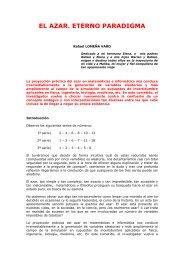
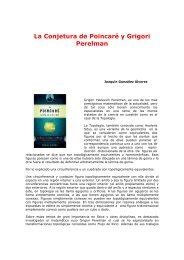
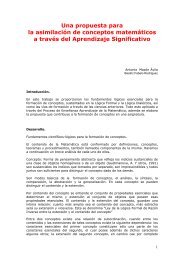

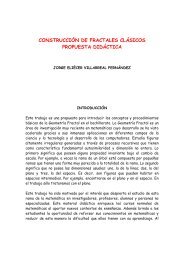
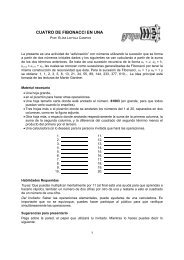
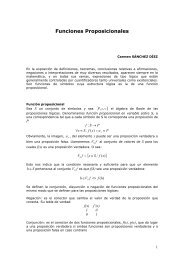
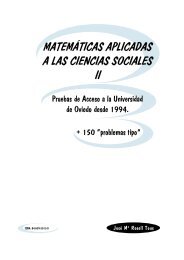
![SOBRE EL CONCEPTO DE CURVA ALGEBRAICA [ ] - Casanchi](https://img.yumpu.com/48842182/1/184x260/sobre-el-concepto-de-curva-algebraica-casanchi.jpg?quality=85)
